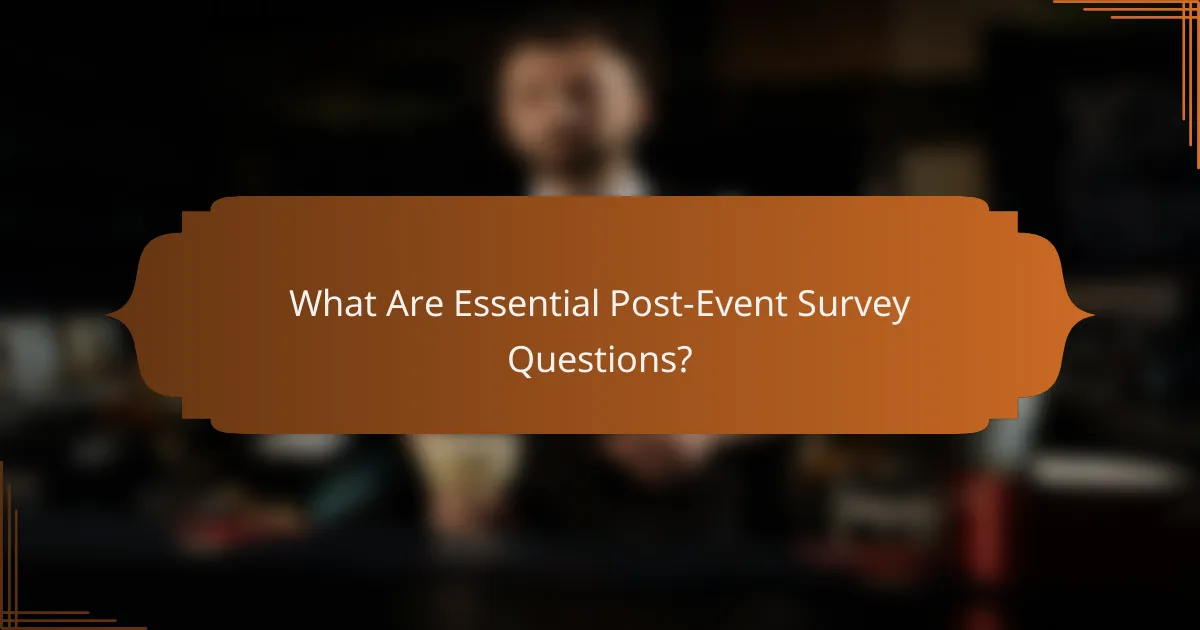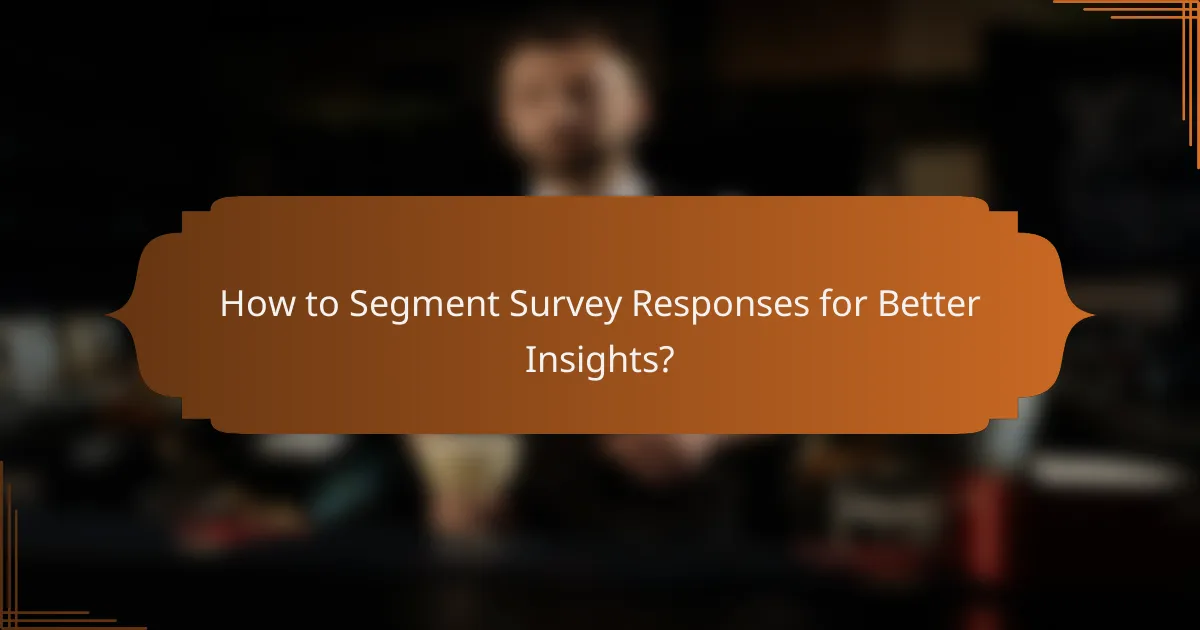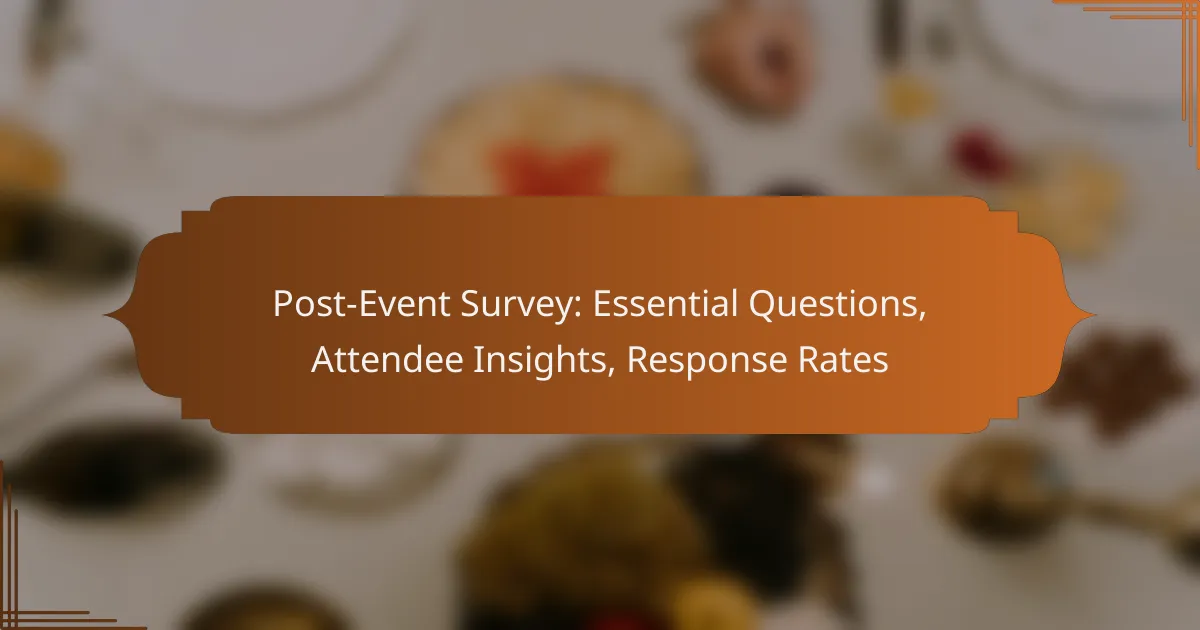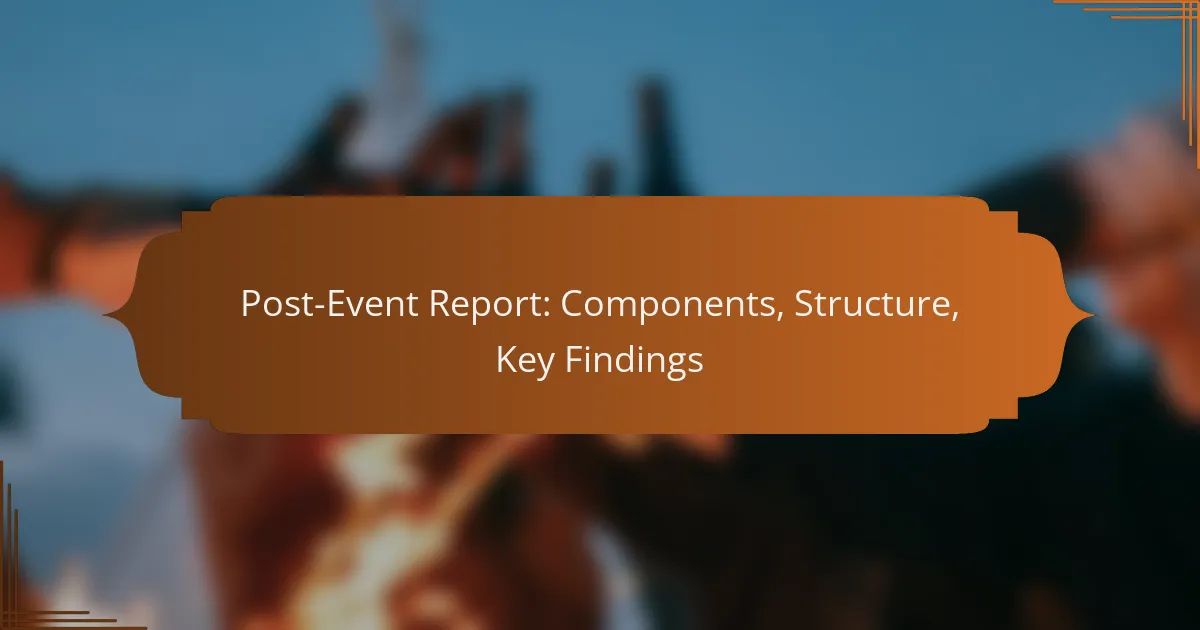Post-event surveys are crucial for collecting valuable insights from attendees regarding their experiences and satisfaction levels. By analyzing both quantitative and qualitative data, event organizers can identify strengths and areas for improvement, ultimately enhancing future events. Implementing targeted strategies to boost response rates, such as offering incentives and personalized follow-ups, can significantly increase participation and feedback quality.

What Are Essential Post-Event Survey Questions?
Essential post-event survey questions help gather valuable insights from attendees about their experiences and satisfaction levels. These questions can guide future event planning and improve overall attendee engagement.
Demographic questions
Demographic questions collect information about the attendees, such as age, gender, location, and occupation. This data helps event organizers understand their audience better and tailor future events to meet the needs of specific groups.
Examples of demographic questions include: “What is your age range?” and “What is your primary occupation?” Keeping these questions concise encourages higher response rates.
Event experience questions
Event experience questions focus on the attendees’ overall experience during the event. These inquiries can cover aspects like venue, organization, and networking opportunities. Asking about specific elements allows organizers to identify strengths and weaknesses.
For instance, questions like “How would you rate the venue?” or “Did the event meet your expectations?” provide actionable insights for future improvements.
Feedback on speakers
Feedback on speakers is crucial for assessing the effectiveness of presentations and workshops. Attendees can provide insights into the speakers’ delivery, content relevance, and engagement levels. This feedback helps organizers select better speakers in the future.
Consider asking questions such as “How engaging was the speaker?” or “Was the content relevant to your interests?” to gather specific feedback.
Suggestions for improvement
Asking for suggestions for improvement allows attendees to voice their opinions on what could enhance future events. This feedback can cover various aspects, from logistics to content delivery. Encouraging open-ended responses can yield valuable insights.
Examples include: “What changes would you recommend for future events?” or “What topics would you like to see covered next time?” This input can guide strategic planning.
Overall satisfaction ratings
Overall satisfaction ratings provide a quick snapshot of how attendees felt about the event. A simple rating scale, such as 1 to 5 or 1 to 10, can effectively gauge satisfaction levels. This metric is essential for measuring success and areas needing improvement.
Consider asking, “On a scale of 1 to 10, how satisfied were you with the event?” This straightforward question allows for easy analysis and comparison across different events.

How to Analyze Attendee Insights from Surveys?
Analyzing attendee insights from surveys involves evaluating both quantitative and qualitative data to understand participant experiences and preferences. This analysis helps identify strengths and areas for improvement in future events.
Quantitative analysis methods
Quantitative analysis methods focus on numerical data collected through surveys, such as ratings and scores. Common techniques include calculating averages, percentages, and response rates to gauge overall satisfaction and engagement levels.
For example, if 80% of attendees rated the event as “excellent,” this indicates a strong positive reception. Utilizing tools like spreadsheets or survey software can streamline the analysis process, allowing for easy visualization of data trends.
Qualitative feedback categorization
Qualitative feedback categorization involves organizing open-ended responses into themes or categories. This method helps identify common sentiments, suggestions, or concerns expressed by attendees, providing deeper insights beyond numerical data.
To categorize feedback, create a list of recurring themes, such as “venue quality,” “speaker effectiveness,” or “networking opportunities.” This structured approach allows for targeted improvements based on attendee comments.
Identifying trends in responses
Identifying trends in responses requires comparing data across different events or time periods to spot patterns. Look for recurring themes in both quantitative scores and qualitative feedback to understand what consistently resonates with attendees.
For instance, if feedback indicates that networking opportunities are frequently mentioned as a highlight, consider enhancing these aspects in future events. Regularly tracking these trends can inform strategic decisions and improve overall attendee satisfaction.

What Are Effective Strategies to Improve Response Rates?
To enhance response rates for post-event surveys, consider implementing targeted strategies that engage attendees and encourage participation. Key approaches include offering incentives, timing the survey distribution effectively, and sending personalized follow-up messages.
Incentives for participation
Offering incentives can significantly boost response rates for your post-event survey. Common incentives include gift cards, discounts on future events, or entries into a raffle for a larger prize. These rewards create a sense of value for attendees, motivating them to take the time to complete the survey.
When selecting incentives, consider your audience’s preferences and the overall budget. A well-chosen incentive can increase participation rates by a noticeable margin, often reaching the low double digits in percentage increases.
Timing of survey distribution
The timing of your survey distribution plays a crucial role in response rates. Surveys sent immediately after an event tend to yield higher engagement, as attendees are still fresh from the experience and more likely to share their thoughts. Aim to distribute the survey within 24 to 48 hours post-event for optimal results.
Additionally, consider the day of the week and time of day when sending the survey. Mid-week mornings often see higher open rates compared to weekends or late afternoons. Testing different timings can help identify the best approach for your specific audience.
Personalized follow-up messages
Sending personalized follow-up messages can significantly increase survey completion rates. Addressing attendees by name and referencing specific aspects of the event they attended can create a more engaging experience. This personal touch shows that you value their feedback and encourages them to participate.
Consider segmenting your audience based on their event experience to tailor your messages further. For example, you might highlight different sessions or speakers relevant to each group. A personalized approach can lead to response rates that are notably higher than generic follow-ups, often improving engagement by several percentage points.

How to Design a Post-Event Survey Template?
Designing a post-event survey template involves creating a structured format that captures attendee feedback effectively. A well-crafted template ensures you gather valuable insights that can inform future events and improve attendee satisfaction.
Key elements of a survey template
A comprehensive survey template typically includes an introduction, a mix of question types, and a closing section. Start with a brief introduction that explains the purpose of the survey and how the feedback will be used. Incorporate multiple-choice questions, rating scales, and open-ended questions to gather diverse insights.
Consider including demographic questions to segment responses by factors such as age, profession, or location. This information can help you analyze trends and tailor future events to specific audiences.
Best practices for question phrasing
When phrasing survey questions, clarity is crucial. Use simple, direct language and avoid jargon to ensure all attendees understand the questions. For example, instead of asking, “How would you rate the overall experience?” you might ask, “How satisfied were you with the event?”
Keep questions focused and specific to avoid ambiguity. Limit the number of response options for multiple-choice questions to five or six to prevent overwhelming respondents. Additionally, consider using a mix of closed and open-ended questions to capture both quantitative and qualitative data.
Tools for creating surveys
Several online tools can help you create and distribute your post-event survey efficiently. Platforms like SurveyMonkey, Google Forms, and Typeform offer user-friendly interfaces and customizable templates. These tools often provide analytics features that can help you interpret the results easily.
When selecting a tool, consider factors such as ease of use, available question types, and integration with other software you may be using. Many of these platforms offer free versions, making them accessible for events of any budget.

What Metrics Indicate Survey Success?
Key metrics that indicate survey success include response rates, completion rates, and Net Promoter Score (NPS). These metrics provide insights into attendee engagement and satisfaction, helping to evaluate the effectiveness of the event and the survey itself.
Response rate benchmarks
Response rate benchmarks typically range from 20% to 30% for online surveys, though higher rates can be achieved with targeted outreach. A response rate above 30% is often considered excellent and indicates strong engagement from attendees. To improve response rates, consider sending reminders and offering incentives.
Completion rate analysis
Completion rates reflect the percentage of respondents who finish the survey compared to those who start it. A good completion rate is generally above 70%, indicating that the survey is engaging and relevant. To enhance completion rates, keep surveys concise and ensure questions are clear and straightforward.
Net Promoter Score (NPS)
Net Promoter Score (NPS) measures attendee loyalty and satisfaction by asking how likely they are to recommend the event to others. Scores can range from -100 to 100, with positive scores indicating more promoters than detractors. A strong NPS, typically above 30, suggests that attendees had a positive experience and are likely to return.

How to Segment Survey Responses for Better Insights?
Segmenting survey responses enhances the quality of insights by allowing you to analyze data based on specific characteristics of attendees. This targeted approach helps identify trends and preferences among different groups, leading to more informed decision-making.
Demographic segmentation
Demographic segmentation involves categorizing survey respondents based on characteristics such as age, gender, income, education level, and location. This method provides a clearer understanding of how different demographic groups perceive the event and their specific needs or preferences.
To implement demographic segmentation effectively, collect relevant data during the registration process or through the survey itself. For example, you might find that younger attendees prefer interactive sessions, while older participants favor keynote speeches. Tailoring future events to these insights can enhance attendee satisfaction.
Be cautious of over-segmentation, which can complicate analysis and dilute actionable insights. Aim for a balance by focusing on the most impactful demographics that align with your event goals. A simple checklist for demographic questions might include age range, gender, and occupation to streamline the process.



